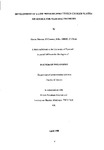DEVELOPMENT OF A LOW PRESSURE-INDUCTIVELY COUPLED PLASMA-ION SOURCE FOR MASS SPECTROMETRY
| dc.contributor.author | O'Connor, Gavin Thomas | |
| dc.contributor.other | School of Geography, Earth and Environmental Sciences | en_US |
| dc.date.accessioned | 2013-09-16T12:36:25Z | |
| dc.date.available | 2013-09-16T12:36:25Z | |
| dc.date.issued | 1998 | |
| dc.identifier | NOT AVAILABLE | en_US |
| dc.identifier.uri | http://hdl.handle.net/10026.1/1764 | |
| dc.description.abstract |
A low pressure-inductively coupled plasma (LP-ICP) ion source has been investigated for the production of atomic and molecular ions for mass spectrometry (MS). A dedicated LPICP- MS was constructed, by modifying a Hewlett Packard mass selective detector, to detect ions from the LP-ICP. The ion sampling interface and ion optics were designed using established theory and the use of a computer simulation program. Perfluorotributylamine was continuously introduced into the LP-ICP, via a molecular leak, and the ion sampling interface, plasma forward power, and plasma gas flow rates, were optimised. When the LP-ICP ion source was sustained at 6W with a gas flow of 6 ml min'* helium, and iodobenzene and dibromobenzene, introduced via GC, only atomic signals for iodine and bromine were observed. Detection limits were 4 and 76 pg for iodobenzene and dibromobenzene respectively. The addition of nitrogen to a LP helium ICP increased the molecular signal for chlorobenzene, resulting in a detection limit of 2 pg. However, the addition of nitrogen did not aid the production of molecular ions of iodobenzene and dibromobenzene. When 0.07 ml min' of isobuiane was added to the LP-ICP mass spectra similar to those obtained by an electron impact source were observed. However, on the addition of more isobutane only the molecular ions (M*) for chlorobenzene, iodobenzene and dibromobenzene were observed. The detection limits for the instrument operating in the molecular mode were 100, 140 and 229 pg for chlorobenzene, iodobenzene and dibromobenzene respectively. Langmuir probe measurements were used to asses the effect of plasma forward power and gas flow rate on the local plasma potential, ion number density, electron temperature and electron number density within the LP-ICP. The local plasma potential varied from +50 V to -20 V depending on the plasma conditions used. The ion and electron number densities increased with increasing plasma power, with ion number densities of approximately 10^ cm' ^ and electron number densities of approximately at 10* cm ^ The effect of extra plasma gas had a less distinct affect on the plasma excited species. A plasma sustained at 6 W, 7 ml min'' helium and 1.8 ml min'* isobutane was used to provide both quantitative and qualitative information of tetraethyllead in the standard reference friel (NBS SRM 1637 II), with .the determined value of 13.06 ± 0.91 being in good agreement with the certified value of 12.9 ± 0.07 expressed as total lead. | en_US |
| dc.description.sponsorship | British Petroleum International, Sunbury-on-Thames, Middlesex, TW16 7LN | en_US |
| dc.language.iso | en | en_US |
| dc.publisher | University of Plymouth | en_US |
| dc.title | DEVELOPMENT OF A LOW PRESSURE-INDUCTIVELY COUPLED PLASMA-ION SOURCE FOR MASS SPECTROMETRY | en_US |
| dc.type | Thesis | |
| plymouth.version | Full version | en_US |
| dc.identifier.doi | http://dx.doi.org/10.24382/4476 | |
| dc.identifier.doi | http://dx.doi.org/10.24382/4476 |
Files in this item
This item appears in the following Collection(s)
-
01 Research Theses Main Collection
Research Theses Main


